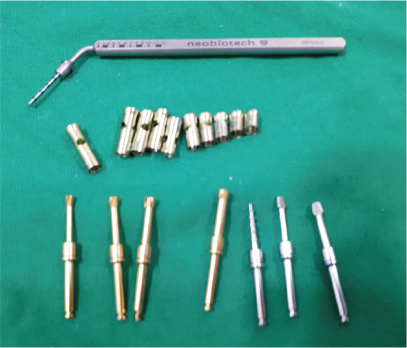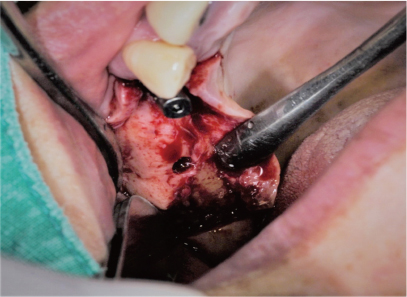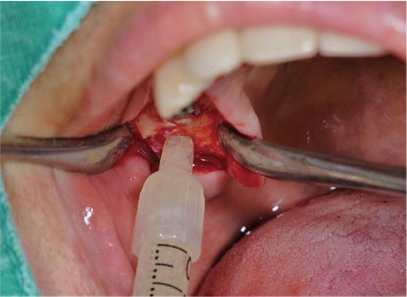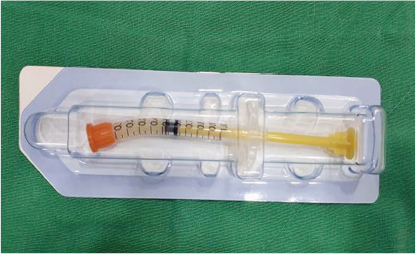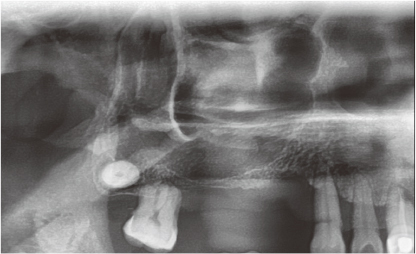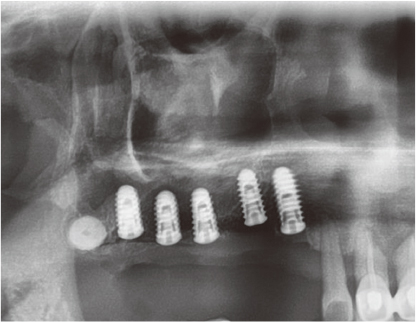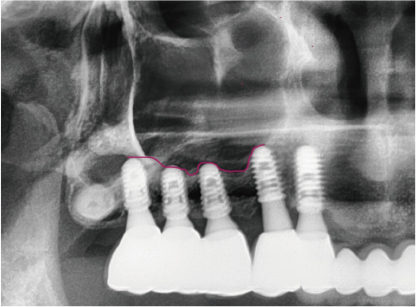J Korean Acad Prosthodont.
2020 Jan;58(1):23-29. 10.4047/jkap.2020.58.1.23.
Success and survival rate of the implant with crestal sinus lift using S-reamer and gel-type graft material: A retrospective study by more 5-years follow check up
- Affiliations
-
- 1Department of Prosthodontics, School of Dentistry, Kyungpook National University, Daegu, Republic of Korea. sungamcho@gamil.com
- KMID: 2469917
- DOI: http://doi.org/10.4047/jkap.2020.58.1.23
Abstract
- PURPOSE
The purpose of this retrospective study was to evaluate the method using the S-reamer and gel-type graft material by the success rate and survival rate.
MATERIALS AND METHODS
Implantation period was from 2008 to 2014, Follow check up year is 2019. There were 59 patients and 117 implants. All implants were placed in the posterior maxilla with the sinus lift. The patients population consisted of 34 men and 25 women, ranging from 19 to 75 years. The residual bone heights were from 1 mm to 6 mm. Sinus was perforated with S-reamer without membrane tearing and gel type bone graft material was used for membrane lifting and filling the space. all implants were placed simultaneously. Panoramic X-ray was taken. After 5 - 6 months healing period, final prostheses were restored. After more 5-years implant surgery, Panoramic X-ray was obtained and X-ray analysis and clinical examination were performed. Success criteria was referred to a Buser's success critera. All implants were classified to success implant, survival implant, failed implant. A success implant was satisfying success criteria, a survival implant was a implant that was acute infection with suppuration and bone loss, a failed implant was a implant that was mobile, removed.
RESULTS
Five implants were removed, and 4 implants had infected with bone loss. Survival rate was 95.7% and success rate was 92.3%.
CONCLUSION
This retrospective study presented that this method with S-reamer and gel-type graft material was a successful treatment without membrane tear in the condition of 1-6 mm residual bone height.
MeSH Terms
Figure
Reference
-
1. Tatum H Jr. Maxillary and sinus implant reconstructions. Dent Clin North Am. 1986; 30:207–229.2. Misch CE, Steignga J, Barboza E, Misch-Dietsh F, Cianciola LJ, Kazor C. Short dental implants in posterior partial edentulism: a multicenter retrospective 6-year case series study. J Periodontol. 2006; 77:1340–1347.
Article3. Petrie CS, Williams JL. Comparative evaluation of implant designs: influence of diameter, length, and taper on strains in the alveolar crest. A three-dimensional finite-element analysis. Clin Oral Implants Res. 2005; 16:486–494.
Article4. Tatum OH. Maxillary sinus grafting for endosseous implant. In : Presented at the annual meeting of the alabama implant study group; April 1977; Birmingham, AL.5. Schwartz-Arad D, Herzberg R, Dolev E. The prevalence of surgical complications of the sinus graft procedure and their impact on implant survival. J Periodontol. 2004; 75:511–516.
Article6. Schwarz L, Schiebel V, Hof M, Ulm C, Watzek G, Pommer B. Risk factors of membrane perforation and postoperative complications in sinus floor elevation surgery: Review of 407 augmentation procedures. J Oral Maxillofac Surg. 2015; 73:1275–1282.
Article7. Katranji A, Fotek P, Wang HL. Sinus augmentation complications: etiology and treatment. Implant Dent. 2008; 17:339–349.
Article8. Summers RB1. A new concept in maxillary implant surgery: the osteotome technique. Compendium. 1994; 15:152154–156. 158 passim; quiz 162.9. Engelke W, Deckwer I. Endoscopically controlled sinus floor augmentation. A preliminary report. Clin Oral Implants Res. 1997; 8:527–531.
Article10. Cosci F, Luccioli M. A new sinus lift technique in conjunction with placement of 265 implants: a 6-year retrospective study. Implant Dent. 2000; 9:363–368.
Article11. Sotirakis EG, Gonshor A. Elevation of the maxillary sinus floor with hydraulic pressure. J Oral Implantol. 2005; 31:197–204.
Article12. Andreasi Bassi M, Lopez MA. Hydraulic sinus lift: a new method proposal. J Osteology Biomaterials. 2010; 1:93–101.13. Buser D, Weber HP, Lang NP. Tissue integration of non-submerged implants. 1-year results of a prospective study with 100 ITI hollow-cylinder and hollow-screw implants. Clin Oral Implants Res. 1990; 1:33–40.
Article14. Lee HW, Lin WS, Morton D. A retrospective study of complications associated with 100 consecutive maxillary sinus augmentations via the lateral window approach. Int J Oral Maxillofac Implants. 2013; 28:860–868.
Article15. Del Fabbro M, Rosano G, Taschieri S. Implant survival rates after maxillary sinus augmentation. Eur J Oral Sci. 2008; 116:497–506.
Article16. Pjetursson BE, Tan WC, Zwahlen M, Lang NP. A systematic review of the success of sinus floor elevation and survival of implants inserted in combination with sinus floor elevation. J Clin Periodontol. 2008; 35:216–240.
Article17. Pikos M. Complications of maxillary sinus augmentation. In : Jensen OT, editor. The sinus graft. 2nd ed. Chicago, IL: Quintessence;2006. p. 103–115.18. Al-Dajani M. Incidence, risk factors, and complications of schneiderian membrane perforation in sinus lift surgery: A meta-analysis. Implant Dent. 2016; 25:409–415.
Article19. Wallace SS, Mazor Z, Froum SJ, Cho SC, Tarnow DP. Schneiderian membrane perforation rate during sinus elevation using piezosurgery: clinical results of 100 consecutive cases. Int J Periodontics Restorative Dent. 2007; 27:413–419.20. Lalo J, Broukris G, Djemil M, Beleh M. Safe technique for sinus floor elevation through alveolar crest with stop sinus osteotomes. Implantodontie. 2005; 14:62–70.21. Bernardello F, Righi D, Cosci F, Bozzoli P, Soardi CM, Spinato S. Crestal sinus lift with sequential drills and simultaneous implant placement in sites with <5 mm of native bone: a multicenter retrospective study. Implant Dent. 2011; 20:439–444.
Article22. Lopez MA, Andreasi Bassi M, Confalone L, Carinci F. Maxillary sinus floor elevation via crestal approach: the evolution of the hydraulic pressure technique. J Craniofac Surg. 2014; 25:e127–e132.23. Kim YK, Lee JY, Park JW, Kim SG, Oh JS. Sinus membrane elevation by the crestal approach using a novel drilling system. Implant Dent. 2017; 26:351–356.
Article24. Rosen PS, Summers R, Mellado JR, Salkin LM, Shanaman RH, Marks MH, Fugazzotto PA. The bone-added osteotome sinus floor elevation technique: multicenter retrospective report of consecutively treated patients. Int J Oral Maxillofac Implants. 1999; 14:853–858.25. Peleg M, Garg AK, Mazor Z. Predictability of simultaneous implant placement in the severely atrophic posterior maxilla: A 9-year longitudinal experience study of 2132 implants placed into 731 human sinus grafts. Int J Oral Maxillofac Implants. 2006; 21:94–102.
Article26. Thor A, Sennerby L, Hirsch JM, Rasmusson L. Bone formation at the maxillary sinus floor following simultaneous elevation of the mucosal lining and implant installation without graft material: an evaluation of 20 patients treated with 44 Astra Tech implants. J Oral Maxillofac Surg. 2007; 65:64–72.
Article27. Johnson GK, Hill M. Cigarette smoking and the periodontal patient. J Periodontol. 2004; 75:196–209.
Article28. Jones JK, Triplett RG. The relationship of cigarette smoking to impaired intraoral wound healing: a review of evidence and implications for patient care. J Oral Maxillofac Surg. 1992; 50:237–239. discussion 239–40.
Article29. Wallace RH. The relationship between cigarette smoking and dental implant failure. Eur J Prosthodont Restor Dent. 2000; 8:103–106.30. Carlsson GE, Lindquist LW, Jemt T. Long-term marginal periimplant bone loss in edentulous patients. Int J Prosthodont. 2000; 13:295–302.31. Kumar A, Jaffin RA, Berman C. The effect of smoking on achieving osseointegration of surface-modified implants: a clinical report. Int J Oral Maxillofac Implants. 2002; 17:816–819.32. Lambert PM, Morris HF, Ochi S. The influence of smoking on 3-year clinical success of osseointegrated dental implants. Ann Periodontol. 2000; 5:79–89.
Article33. Hinode D, Tanabe S, Yokoyama M, Fujisawa K, Yamauchi E, Miyamoto Y. Influence of smoking on osseointegrated implant failure: a meta-analysis. Clin Oral Implants Res. 2006; 17:473–478.
Article34. Misch CE. Progressive bone loading. In : Misch CE, editor. Dental implant prosthetics. St. Louis: Mosby;2005. p. 511–530.35. Appleton RS, Nummikoski PV, Pigno MA, Cronin RJ, Chung KH. A radiographic assessment of progressive loading on bone around single osseointegrated implants in the posterior maxilla. Clin Oral Implants Res. 2005; 16:161–167.
Article36. Siadat H, Panjnoosh M, Alikhasi M, Alihoseini M, Bassir SH, Rokn AR. Does implant staging choice affect crestal bone loss? J Oral Maxillofac Surg. 2012; 70:307–313.
Article37. Ozyuvaci H, Bilgiç B, Firatli E. Radiologic and histomorphometric evaluation of maxillary sinus grafting with alloplastic graft materials. J Periodontol. 2003; 74:909–915.
Article
- Full Text Links
- Actions
-
Cited
- CITED
-
- Close
- Share
- Similar articles
-
- Survival rate of Astra Tech implants with maxillary sinus lift
- Installation Immediate Implant with Sinus Lift Crestal Approach Technique: A Case Report of 4-year Follow-up
- THE COMPARATIVE EVALUATION USING HATCH REAMER TECHNIQUE AND OSTEOTOME TECHNIQUE IN SINUS FLOOR ELEVATION
- Clinical Study on Implant Survival and Graft Resorption Rate After Maxillary Sinus Bone Grafting
- A clinical study of maxillary sinus lift for dental implant

